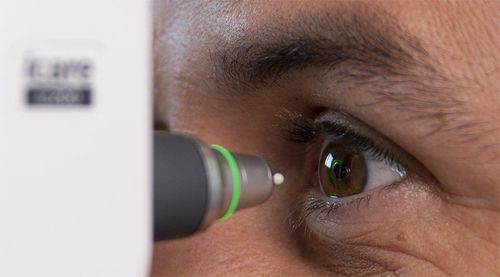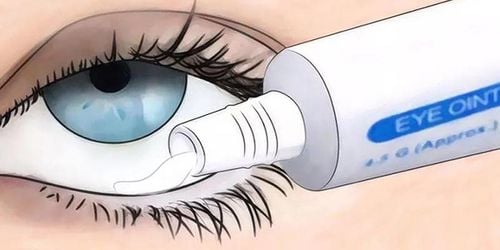This is an automatically translated article.
The article was professionally consulted with Master, Doctor Hoang Thanh Nga - Ophthalmologist - Department of Medical Examination & Internal Medicine - Vinmec Ha Long International General Hospital.Uveitis is a fairly common eye disease, common at all ages, with a complex etiology, often causing severe damage, many complications, or recurrence and can lead to blindness if are not treated promptly or do not persist in the treatment process. Read on to learn more about the uveitis pictorial guide below.
1. A Visual Guide to Uveitis
1.1. What is ocular uveitis? The uvea has three parts: the iris, the ciliary body, and the choroid. This is where many blood vessels are located, including the veins and arteries that carry blood to the eye. Uveitis is inflammation of one of the three parts mentioned above. The disease can affect the lens, retina, and optic nerves. Depending on the location of the lesion, people will be divided into 3 types:Anterior uveitis (iritis - blepharitis): The most common form, accounting for about three-quarters of cases of uveitis dig. The disease often recurs in episodes and if not treated well can cause glaucoma, permanent blindness. Medial uveitis (mainly posterior to the ciliary body): Symptoms are rather poor and often blurred vision accompanied by flies in front of the eyes. Posterior uveitis: Usually inflammation of the back of the eye, inflammation of the choroid, the retina damages the optic nerve, limiting vision for the patient. In some cases, uveitis can affect the entire front and back of the eye. This is called total uveitis.
1.2. Causes and symptoms of uveitis Causes of uveitis
There are common causes of uveitis as follows:
Inflammation: Inflammation can be caused by bacteria (accumulators) streptococci, gonorrhea, bacilli, viruses (herpes), fungi (candida) or parasites (toxoplasma gondii). Due to poisoning: from food or chemicals... Due to an autoimmune disease (your body has antibodies against the uvea) Trauma: a blunt trauma and then uveitis. Secondary to systemic diseases: collagenose, sarcoidose, Behcet's disease, dermatosis and blood disease. Certain cancers like lymphoma are rare but can also indirectly damage the eye. In addition, there is uveitis of unknown cause.

Có nhiều nguyên nhân khác nhau gây ra bệnh viêm màng bồ đào
Symptoms can come on suddenly or develop silently over a long period of time and will only be detected during routine eye exams.
Symptoms include:
Eye pain is the most common symptom. The pain can come on as dull or sudden and increase when you focus your attention on a certain point. Red eyes are a sign of inflammation caused by congested blood vessels. Vision is impaired and it feels like a fog is covering your eyes. Sensitivity to light (photophobia). Flies flying in front of your eyes: you can see black dots, or shadows moving in front of your eyes when your eyes are fixed on one spot. Loss of peripheral vision is the ability to see objects and movement of objects outside the path of vision will be reduced. Pupils have different shapes or fail to shrink in response to light. Systemic manifestations may include: mild fever, loss of appetite, poor sleep, headache, ... Recognizing uveitis
Your vision may be blurred. You may experience redness and pain. Uveitis can come on slowly. This disease, which can affect one or both eyes, usually affects your uvea, but it can affect any part of your eye, including the cornea (the clear coating at the front of your eye). yours), or the white part, called the sclera.
You may have:
Sensitivity to light "Floating" in your vision A white spot called hypopyon in the lower part of your eye If light bothers you, or you have eye pain or any change in vision, see an ophthalmologist immediately.
For the case of anterior uveitis, the patient will usually go to the doctor because of redness, pain, and glare, but these signs are often confused with conjunctivitis (pink eye).
For diagnosis, the patient needs to have an eye exam with an Ophthalmologist and examine under a microscope to easily detect inflammation inside, not inflammation on the surface of your eye.
Who often suffers from uveitis?
Uveitis can occur in all subjects from young children to the elderly. One of the dangers of uveitis is that it comes back again and again and even causes blindness when the cause is not properly treated. The disease can cause eye damage such as cataracts (cataract) or cataracts (glaucoma) as a side effect of anti-inflammatory drugs or eye surgery when the inflammatory response is not well controlled, so Patients with uveitis should be diagnosed and ruled out for possible causes prior to treatment with anti-inflammatory drugs alone to avoid further complications or the risk of blindness.
How to detect when uveitis?
An eye exam will be performed by an ophthalmologist, who will ask about your medical history. Next you will get:
Optometry Order blood tests if needed Ophthalmology . This will check for another eye condition called glaucoma. Examination with slit lamp microscopy. This will give the doctor 3D images of the anterior parts of the eye to detect signs of inflammation around the eye. Dilate the pupil to look at the ophthalmoscope, check for damage to the fundus? How does uveitis progress?
Depending on the cause of the uveitis, there are cases where acute uveitis occurs quickly, early and only needs one treatment to be cured. However, most uveitis is progressive. recurs often and even lasts for a long time for many years when the right cause is not found.

Bệnh viêm màng bồ đào cần được xác định và điều trị sớm
Uveitis is very rare, affecting around 2 to 5 people in every 10,000 people in the UK each year. It is most common in people between 20 and 59 years old, but it can sometimes affect children as well.
Uveitis complications
Uveitis can sometimes lead to other problems, especially if it's not treated quickly and properly.
Some of the more common complications of uveitis include: glaucoma - where the optic nerve, which connects your eye to your brain, is damaged; it can lead to vision loss if not detected and treated early, cataracts - in which changes in the lens of the eye cause it to become less transparent, resulting in blurred vision or blur. Cystic macular edema - swelling of the retina (thin, light-sensitive tissue at the back of the eye).
Uveitis can affect some people with long-term uveitis if the uveitis is not treated quickly: the retina detaches when the retina begins to withdraw from the blood vessels that supply oxygen and nutrients for it; synechiae after inflammation causes the iris to become attached to the lens of the eye.
If left untreated, uveitis can lead to serious eye problems, including blindness. It is one of the leading causes of vision loss in working-age people.
You are more likely to develop complications of uveitis if:
You are over 60 years old You have long-term (chronic) uveitis You have less common types of uveitis affecting to the middle or back of the eye (medial or posterior uveitis)

Độ tuổi và bệnh viêm màng bồ đào có mối liên quan mật thiết với nhau
2. How to treat, care and prevent uveitis
Treatment of uveitis: The basic thing is to find the cause of the disease to treat it completely. For example: tuberculosis uveitis, if the patient has no external symptoms such as pulmonary tuberculosis but only TB in the eye, the machine can correctly diagnose and treat according to the regimen of uveitis. due to tuberculosis. Either the uveitis caused by autoimmune disease must be treated with anti-inflammatory drugs or long-term immunosuppressive drugs to control the disease. Treatment will depend on the cause. Anti-inflammatory medications are often the first step. These are usually eye drops or ointments. You can also take a pill or an injection because neither the drops nor the ointment get into the middle or back of the eye. The goal is to treat inflammation. Once your care is complete, you'll need to have your eyes checked regularly to prevent damage and loss of vision. Care for uveitis: The most important thing for uveitis patients is to be followed up with regular follow-up exams on time because most patients with uveitis do not see the doctor on time and do not take the right medicine. indicated and when not followed up on time, the side effects of the drug can outweigh the therapeutic effects. How to prevent and avoid recurrence of uveitis: The characteristic of uveitis or recurrence is that the cause has not been found or the inflammatory response is not controlled, so prevention on the part of the patient is cannot. On the part of the treating doctor, it is necessary to trace back and find the cause, or use stronger drug treatments, immunosuppressive measures to control the disease longer and avoid the side effects of the disease. medicine.=>>Advice from Master, Doctor Hoang Thanh Nga - Ophthalmologist - Department of Medical Examination & Internal Medicine - Vinmec Ha Long International General Hospital: Uveitis is a dangerous disease that affects severe damage to visual function. Therefore, when there are symptoms, it is necessary to go to an eye doctor immediately to determine the cause and extent of the disease, thereby helping to timely treat and avoid complications. Vinmec International General Hospital has full human resources and modern equipment to help diagnose and treat eye diseases.
Eye specialist at Vinmec has comprehensive vision and eye health care functions for children, adults and the elderly including: refractive error check, laser treatment and surgery. In addition, the department also has the task of coordinating with other clinical departments in the treatment of pathological complications and eye injuries caused by accidents. In addition, the team of Ophthalmologists at Vinmec are experienced doctors who have performed many types of surgery from routine to difficult surgeries, especially those requiring aesthetics. With enthusiasm and love for the profession, the team of doctors working at Vinmec always gives customers the best services with the highest service quality.
Please dial HOTLINE for more information or register for an appointment HERE. Download MyVinmec app to make appointments faster and to manage your bookings easily.
Reference source: webmd.com












